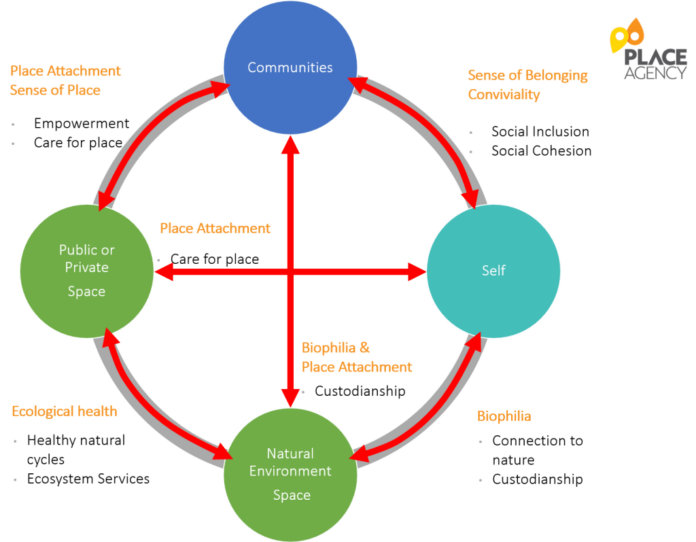Placemaking, a construct within the framework of human geography, encapsulates an interdisciplinary approach that interweaves the physical, social, and emotional aspects of the spaces we inhabit. As societies evolve, the importance of place escalates, making it essential to understand how placemaking can influence cultural identity, social interactions, and community resilience. This essay delineates the definition of placemaking, its historical significance, and its implications within the realm of human geography.
At its core, placemaking entails the process by which individuals and communities collaboratively create, interpret, and enhance public spaces. The idea transcends mere urban design; it is a holistic endeavor that emphasizes the emotional and experiential dimensions of space. Through participatory methods, placemaking nurtures a sense of belonging, fosters community ties, and engenders inclusivity. As diverse as the communities it serves, placemaking adapts to local contexts, drawing from the cultural zeitgeist while addressing practical concerns such as accessibility, safety, and sustainability.
The concept of placemaking can be traced back to several theoretical frameworks within human geography, sociology, and urban studies. Scholars such as Edward Relph and Yi-Fu Tuan have explored the intricate relationship between place and identity. Relph’s work posits that places are laden with meanings that shape human experiences, while Tuan emphasizes the phenomenological aspects of space, suggesting that our interactions with places nurture our identities. These academic insights underscore that placemaking is not merely an act of physical arrangement but a profound engagement with the essence of a community’s historical and cultural tapestry.
Recognizing the historical significance of placemaking, we must situate this practice within a broader socio-political context. Across the globe, placemaking has played a critical role in historical struggles for identity and autonomy, particularly among marginalized communities. The civil rights movement in the United States, for example, illustrates how reclaiming public space became intrinsic to the fight against systemic oppression. The act of congregating in parks, streets, and squares transformed these locales from mere geographical markers into arenas of resistance and empowerment.
Furthermore, the relationship between placemaking and nation-building cannot be overlooked. In various geopolitical settings, the transformation of public spaces has served as both a means and a symbol of independence. Following decolonization in numerous African nations, leaders recognized that the reimagining of public spaces could foster national identity and unity. Monumental architecture, public squares, and communal gardens became emblematic of the newly minted sovereignty, acting as tangible representations of a collective aspiration for autonomy and recognition.
The social dimensions of placemaking extend beyond cultural identity to encompass communal participation and social justice. As urban areas become increasingly diverse, the need for inclusive practices in placemaking becomes paramount. Effective placemaking requires engaging with various stakeholders—residents, local organizations, governments, and businesses—to cultivate spaces that are representative of the broader population. This participatory approach not only refines the physical characteristics of a place but also contributes to a shared governance model, enhancing social cohesion and community agency.
Moreover, the importance of accessibility in placemaking cannot be overstated. Urban designers and planners are now challenged to create environments that cater to all demographics, including individuals with disabilities, the elderly, and low-income populations. Historically, urban spaces have often marginalized these groups, perpetuating inequalities. Through the lens of social equity, placemaking serves as a corrective framework that seeks to mitigate spatial disparities and promote universal design principles, creating spaces that are welcoming and adaptable to varying needs.
The sustainable dimensions of placemaking have gained traction in recent years amid urgent environmental concerns. Climate change and urbanization necessitate a reexamination of how public spaces are utilized and designed. The integration of green spaces, such as parks and urban gardens, is fundamental not just for aesthetic enhancement but also for ecological functionality. These spaces support biodiversity, improve air quality, and contribute to mental well-being. Consequently, placemaking engenders resilience against environmental challenges while promoting sustainable urban living.
With technological advancements, the nature of placemaking is evolving. Digital placemaking harnesses tools such as social media, mobile applications, and participatory mapping technologies, enabling communities to engage in real-time dialogues about their shared spaces. Virtual platforms can catalyze interest, gather diverse opinions, and foster solidarity within communities, allowing for a more dynamic and responsive approach to urban development.
Educational institutions also play a pivotal role in advancing placemaking within communities. By integrating placemaking principles into curricula, universities can equip future generations with the knowledge and tools necessary to create engaging public spaces. Interdisciplinary programs that combine urban studies, environmental science, and social justice produce graduates who are adept at addressing spatial inequities while fostering community engagement.
To sum up, placemaking is an essential aspect of human geography that extends well beyond physical arrangements of spaces. It encapsulates historical struggles, social inclusivity, environmental sustainability, and technological integration. As communities continue to navigate the complexities of urban living, understanding the profound significance of placemaking offers invaluable insights into how we can cultivate resilient, vibrant, and inclusive urban landscapes. While challenges remain, the trajectory of placemaking illuminates a pathway toward more engaged, sustainable, and equitable communities—a testament to the enduring power of place in defining the human experience.





























